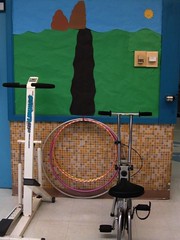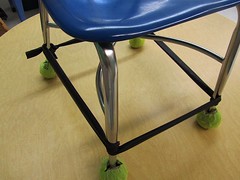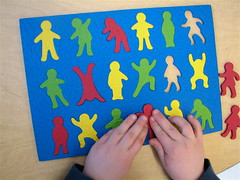I bought myself an
iPad last summer and work has not been the same. To explain this best, I thought I would give you "snip-its" of my day today with one in hand.
As I walk into school, my
briefcase is much lighter. I leave my school lap top at work now and in its place is the feather weight
iPad. It is amazing how heavy those school laptops are!
I stop in a kindergarten class to work with a youngster with weak hands and poor fine motor skills. He is finishing up a center activity, a mosaic paper tearing task. I demonstrate how to tear paper with the tips of his fingers instead of a whole hand grasp. He signs his name on the back with a more confident signature. His lines are darker and straighter instead of light and wavy. It must be the prior finger activity preparing his muscles and joints. Next, we use
pop-toobs as a two-handed task to build arm strength. They make a very
satisfying sound. After stretching them out, I have him put one end to his ear as he repeats positive affirmations ("I am amazing") in the other end.

We open the
iPad and use
Doodle Buddy to practice drawing a person. We sing the
Mat Man song to help guide his drawing of body parts. By holding down the home button and on/off switch at the same time, we take a photo of his drawing. He goes to the photo app and compares the drawing with one he drew several weeks ago.


Finally

, we open the
Dexteria app to the Tap IT activity, a finger dexterity and isolation task. He is learning to isolate individual finger movements, something needed in order to manipulate a pencil to form letters, type on a keyboard or play a musical instrument.
Hmm...he has improved over the past month when
all his fingers moved at once.

I consult on a youngster in second grade with challenges in attention, sensory regulation and motor output. As I walk into his classroom, he is finishing up a story on crocodiles. I check up on the writing strategies we developed for him. After just 5 minutes of working with him, it is snack time (you don't own the schedule when you are a school based therapist!). The student is ready to be done with writing, and is hungry to boot! As he eats his snack, we keep the focus on crocodiles. His most recent page in his story is on crocodiles and predators, so we look up more information by googling this using Safari. Because the
iPad is "instant on", we don't miss a beat. If I was waiting for a laptop to open up, I might have lost his interest. We discover an interesting article on Animal Planet. I read the information to him, but he could have listened to it using
VoiceOver (an accessibility feature built right into the
iPad). Next, I refine the search to images. This brings up many intriguing photos of crocodiles and their predators. The student remains engaged, building his knowledge base. He scrolls through the images, enlarging them with a two finger touch and goes to the link to get more information. After snack, he hasn't "checked out". He uses his writing checklist to make corrections in his story for capitalization, punctuation and spelling. He then transitions to the next activity, energized from this experience. The
iPad supports the
third principle of UDL, for sure!
After lunch, I have an
IEP meeting. Several years back I took notes by hand. I was a terrible filer and I struggled with an ever-growing pile of paper on my desk. Last year I moved to typing notes on a laptop. I never liked the separation a laptop created on a table. Often, I would keep the laptop on my lap to avoid this.
Toda
y, I open
Notes and start a new page for this meeting. The
iPad can sit flat or with a slight incline. It does not create a barrier between you and others at the table. It is like writing on a piece of paper. We consider different writing support programs for this student. One is
Clicker 5. As the special educator explains the program to the regular ed teacher, I bring up the website and show an image of the tool. As the meeting adjourns, I put my
iPad to sleep. This is one note I will not misplace on my desk.
At the end of

the day, I open the
First Class app and send a few follow-up emails.
My day with an
ipad...doing things differently. I wouldn't have it any other way.








































